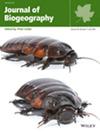Island Biogeography Theory and the Island Rule in Orchid Bees in Panama
Abstract
Aim
The study of the theory of island biogeographic (TIB) has focused mainly on plants and vertebrates, with support for the predictions that species richness decreases with distance from the mainland and increases with island size. However, less work has been done on invertebrates. Similarly, the study of the island rule has been studied mainly in vertebrates. A group of invertebrates that can facilitate the study of TIB and the island rule are orchid bees (Apidae: Euglossini), because they are easily collected and show powerful flight performances that allows them to travel long distances. We wondered if these bees would follow the predictions of island biogeography, given that their populations may not be isolated across islands. To test if there is an homogenitazion of orchid bee communities across islands, we evaluated orchid bees abundance and species composition across islands. Besides, we tested the island rule by examining body size variations in individuals collected across islands.
Location
Coiba National Park (Panama).
Time Period
May and June 2023.
Taxa
Orchid bees (Hymenoptera: Apidae: Euglossini).
Methods
By using traps with chemical attractants, we sampled male bees from five islands and the mainland in Coiba National Park in the Pacific side of Panama. We tested the TIB by evaluating whether richness decreased with distance from the mainland or whether increased with island area. To investigate the island rule, and whether there is variation in body size across islands, we used Euglossa imperialis and Euglossa mixta as models, the two most abundant species in the study area.
Results
For the overall orchid bee community, we found that our results fit one of the predictions of IBT, increases in orchid bee abundance with island area; however, species richness did not decrease with isolation and did not increase with island area as predicted by TIB. An interesting result was that as distance from the mainland increased few species became more dominant. Regarding the island rule, we found in the two Euglossa species a marked pattern of reduction in body size as distance from the mainland increased, which seems to outweigh the effect of island size, since the largest island and one of the farthest showed some of the smallest body sizes.
Main Conclusions
Whether euglossine bees travel long distances across islands in marine environments remain unclear. As distance from the mainland increases, few species become dominant, which may be caused by a decrease of resources that favours generalist species. This increase in abundance may explain the decrease in body size with isolation, as perhaps competition for resources increases. Our study provides novel insights to better appraise the dynamics of orchid bees' communities in insular habitats.

 求助内容:
求助内容: 应助结果提醒方式:
应助结果提醒方式:


